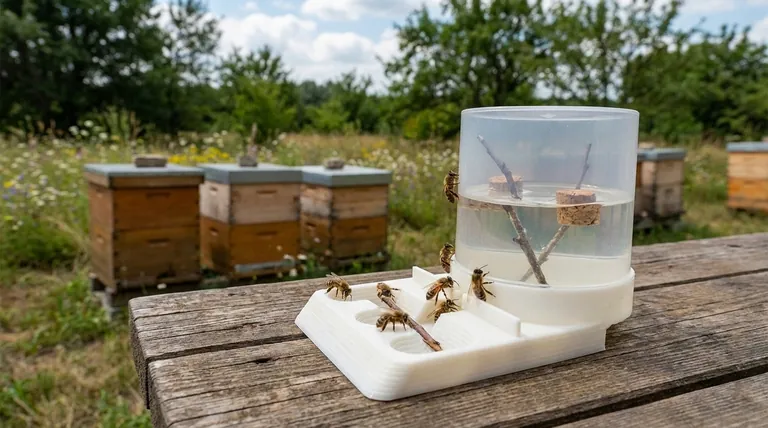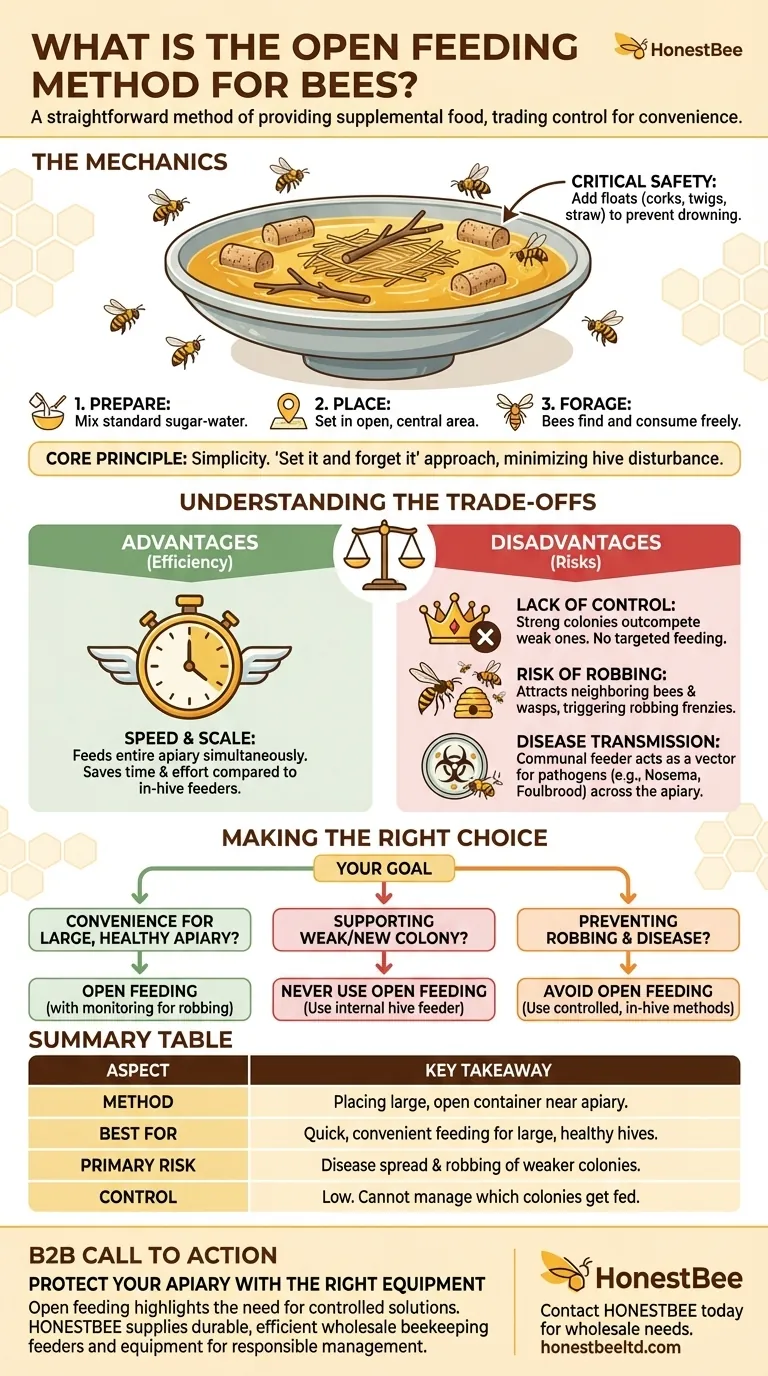Open feeding is a straightforward method of providing supplemental food to honey bees. In this technique, a beekeeper places a large, accessible container of sugar syrup, such as a bucket or bird bath, in an open area near the apiary, allowing bees from multiple hives to find and consume the food freely.
The central concept of open feeding is trading control for convenience. While it is the fastest and easiest way to offer food to an entire apiary, it relinquishes your ability to manage which colonies get fed and introduces significant risks like disease spread and hive robbing.

The Mechanics of Open Feeding
The appeal of open feeding lies in its simplicity. It requires minimal equipment and interaction with the hives, making it a popular choice for beekeepers managing numerous colonies or those seeking a low-maintenance approach.
How It Works
The process involves preparing a standard sugar-water mixture and pouring it into a large, shallow container. This container is then placed in a familiar, central location where bees can easily find it. The bees forage on this artificial nectar source as needed throughout the day.
The Core Principle: Simplicity
Open feeding is designed to be a "set it and forget it" solution. You provide the food source, and the bees manage the collection. This method avoids the need to open individual hives, which reduces disturbance to the colonies and saves the beekeeper a significant amount of time and effort.
A Critical Safety Precaution
A vital step in open feeding is preventing the bees from drowning in the syrup. The container must be filled with objects that serve as landing platforms and ladders. Common materials include wine corks, twigs, gravel, or straw, which allow bees to safely access the syrup without falling in.
Understanding the Trade-offs
Choosing a feeding method is not just about convenience; it's about understanding the impact on your colonies. Open feeding presents a clear set of advantages and serious disadvantages that every beekeeper must weigh.
The Primary Advantage: Efficiency
The main benefit is speed and scale. A single, large feeder can serve an entire yard of hives simultaneously. This is far less strenuous and time-consuming than filling individual in-hive feeders for every single colony.
The Major Drawback: Lack of Control
With open feeding, you have no way of knowing which colony is taking the food. Strong, dominant colonies will often outcompete weaker ones, meaning the hives that most need the supplemental food may get very little. This can worsen the imbalance in your apiary.
The Risk of Robbing
A large, open food source is a powerful attractant. It will draw not only your bees but also bees from neighboring apiaries and other insects like wasps. This can trigger a "robbing frenzy," where strong colonies begin to attack weaker hives in the area to steal their stored honey, often leading to the collapse of the weaker colony.
The Potential for Disease Transmission
A communal feeding station is an ideal vector for spreading diseases. If bees from an infected colony visit the feeder, they can easily transmit pathogens like nosema or foulbrood to healthy bees from other colonies, potentially spreading sickness throughout your entire apiary and even to neighboring ones.
Making the Right Choice for Your Goal
Your decision to use open feeding should be based on your specific goals and your tolerance for risk.
- If your primary focus is convenience for a large, healthy apiary: Open feeding can be a fast way to provide general support during a nectar shortage, assuming you can monitor for robbing.
- If your primary focus is supporting a specific weak or new colony: Never use open feeding. An internal hive feeder is the only way to ensure that targeted colony receives the resources it needs.
- If your primary focus is preventing robbing and disease spread: Avoid open feeding entirely and use controlled, in-hive methods to maintain apiary health and biosecurity.
Ultimately, understanding these fundamental trade-offs allows you to feed your bees in a way that is both effective and responsible.
Summary Table:
| Aspect | Key Takeaway |
|---|---|
| Method | Placing a large, open container of syrup near the apiary. |
| Best For | Quick, convenient feeding for a large number of healthy hives. |
| Primary Risk | Can spread disease and trigger robbing of weaker colonies. |
| Control | Low. You cannot control which colonies get fed. |
Protect Your Apiary with the Right Equipment
Open feeding highlights the critical need for controlled, in-hive feeding solutions to ensure colony health and prevent robbing. For commercial apiaries and beekeeping equipment distributors, having reliable supplies is non-negotiable.
HONESTBEE supplies durable, efficient beekeeping feeders and equipment through our wholesale-focused operations. Ensure your colonies get the nutrition they need without the risks.
Contact HONESTBEE today to discuss your wholesale needs and secure the right equipment for responsible apiary management.
Visual Guide

Related Products
- HONESTBEE Entrance Bee Feeder Professional Hive Nutrition Solution for Beekeeping
- HONESTBEE Entrance Bee Feeder Efficient Hive Front Liquid Feeding Solution for Beekeeping
- Professional Hive Front Entrance Bee Feeder
- HONESTBEE Professional Hive Top Bee Feeder Feeding Solution
- Boardman Entrance Bee Feeder Durable Galvanized Steel and Wood Construction for Beekeeping
People Also Ask
- How does the entrance feeder method work? A Guide to Simple But Risky Hive Feeding
- What are the different types of honey bee feeders? Choose the Right Feeder for Your Hive
- What is a common problem with hive front feeders? Avoid Robbing Frenzies and Protect Your Hives
- How do you make an entrance feeder for bees? A Guide to Safe & Effective Hive Feeding
- Are entrance feeders good for bees? Prioritize Hive Health Over Convenience



















